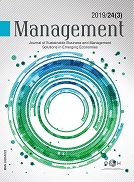Liquidity profitability trade-off: Evidence from medium enterprises
DOI:
https://doi.org/10.7595/management.fon.2019.0004Keywords:
liquidity, profitability, cash flow, financial analysis, polluting medium enterprisesAbstract
Research Question: This paper examines the impact of liquidity on the profitability of the Serbian polluting medium sized enterprises. Motivation: We study the impact of traditional liquidity indicators and indicators based on cash flow on the profitability. In domestic literature, a contribution in the field of financial stability analysis based on cash-flow is rare, consequently we use cash flow indicators as a liquidity measure. Focus of this paper is on the medium sized enterprises in Serbia being the major sources of environmental pollution. Medium-sized enterprises are the main drivers of economic growth. For improving environmental performance and applying technologies and processes that meet environmental requirements, it is necessary the liquidity and profitability improvement. The progress in the area of environmental protection is the relevant part of the accession process of Serbia to the EU. Idea: The idea of this paper was to empirically examine the liquidity profitability trade-off of selected enterprises. The research was conducted using return on assets as the dependent variable, and three liquidity ratios and three cash flow based indicators as independent variables. Data: The financial analysis is based on the sample of 48 polluting medium-sized enterprises for the period 2010-2015. The official financial statements were taken from the Serbian Business Registers Agency. The data are used on an annual basis. Tools: We tested the panel regression model of profitability with the total number of observations being 288. We estimated the unbalanced panel because our dataset had missing values. It is used the standard pooled OLS estimator. Before estimated panel regression model, we did stationarity and cointegration analysis of sample data. Findings: The results of our study show a significant impact of quick liquidity ratio, cash flow operating margin and cash flow investing margin on profitability measured by return on assets. However, there are no significant effects of current liquidity ratio, operating cash flow liquidity ratio and cash flow financing margin on profitability. The conclusions of our paper refer to the selected enterprises in the observed periods. Contribution: This paper contributes both to the literature concerning liquidity and profitability analysis, since we use cash flow indicators as a liquidity measure.








